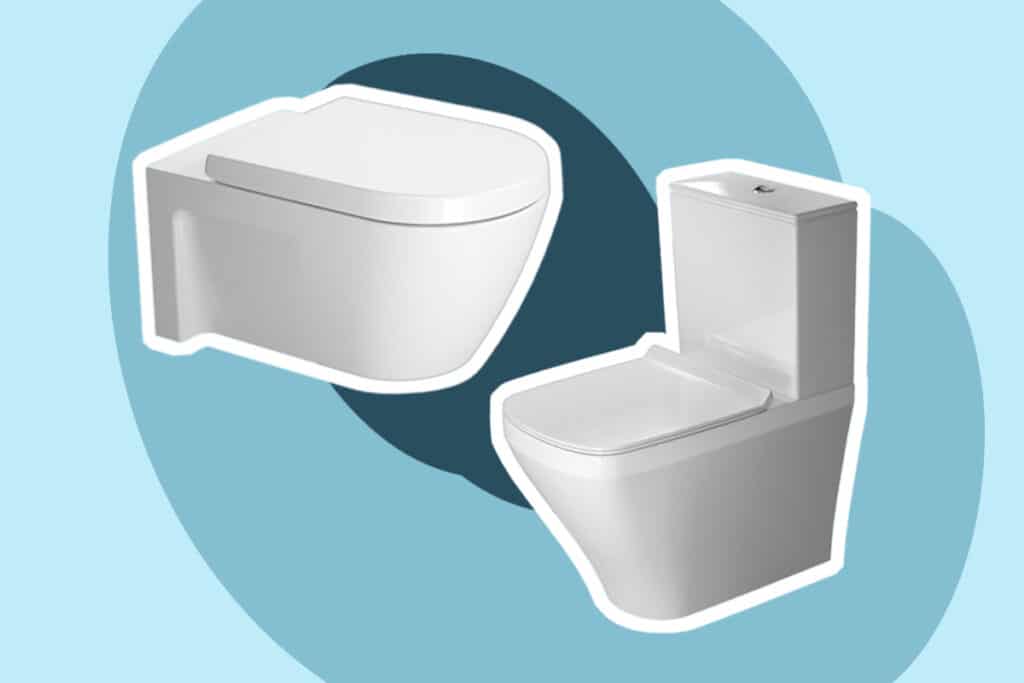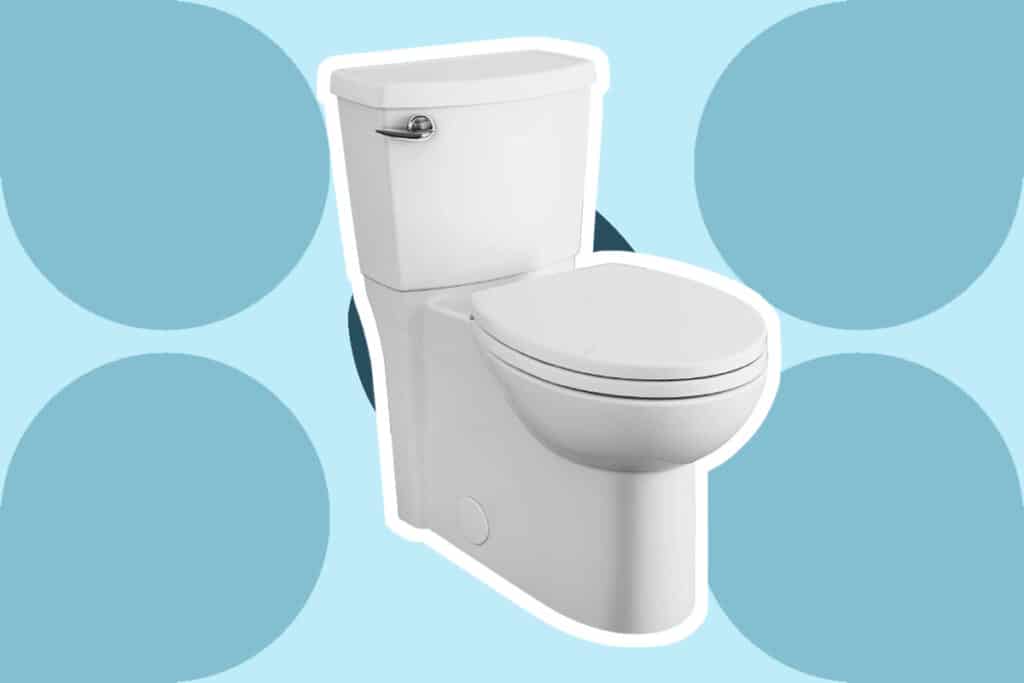

A clogged toilet is like a natural disaster – it comes on suddenly, requires immediate action, and makes life a nightmare for the household. A clog in the bathroom can be caused by natural organic waste, but more often by not water-soluble objects. It can be construction debris, rags, plastic bags, and bits of thick paper, the contents of the pet’s loo, small children’s toys, and other items that may have got there through your fault or that of your household mates. So, how to unclog a toilet when nothing works?
When water flows over the edge, you should not even try to force it through. Call the utility company immediately. In most cases, when the toilet is clogged, you don’t need to call a plumber because you can clean the sewer pipe at home using improvised means. Let’s find out how to clean the toilet yourself.
How do you clean a clogged toilet without using chemicals? Mechanical methods of cleaning are suitable for this, which involve the use of specific tools.
If you suspect that a solid, insoluble object has entered the drainpipe, e.g., a paper or cloth has clogged the toilet bowl, you should try to remove it directly by hand. This procedure may be the quickest and most effective. First of all, protect yourself by wearing rubber gloves on your hands and possibly covering your nose with a gauze bandage. Then put your hand into the drain and feel for the cause of the blockage. You can easily pull a rag and coarse debris out of the pipe with your hands.
The plunger is probably the first thing that comes to mind when you ask yourself how to clear a blockage in the toilet with your hands. And if you don’t have one, we recommend getting one, as it successfully solves the problem of small debris entering the drain.
The principle of work of this design is based on the force of pressure. The progressive movement of the plunger expels the water and forces it through the blockage. The water passes further into the standard drain or breaks through to the outside.
In this case, the work method is simple: the plunger is placed in the place of planned water removal (toilet flush), and then the plunger is sharply moved up and down to dislodge stagnant feces and debris and clear the blockage.
This method is suitable for both classic WC design and modern models.
Such a device is rare in ordinary flats, as it is considered a professional plumber’s tool. If, fortunately, you do have one, attach a sharp nozzle or a piece of thick wire (if necessary) to one end of it. This construction is dipped into the toilet bowl as far as it will go and twisted the handle clockwise. Even very far away, Plumbing Snake can reach blockages with the cable, after which it is advisable to clean the system with one of the particular products or use hot water.
The cleaning process is best carried out by two persons, one who rotates the crank (the rope turns accordingly) and the other who introduces the device into the drain. To perform the work more effectively, it is advisable to periodically change the direction in which the rope is moved (back and forth) to deform the clog that has formed.
However, in some complicated cases, Plumbing Snake can only solve the problem by repeatedly inserting the cable by extracting the contaminant in stages. For this purpose, it is recommended to periodically remove the rope from the sewer and use it again after cleaning the toilet bowl of impurities.
Of course, introducing the presented method for cleaning the toilet bowl from a clog at home assumes collective work and attention of executors so as not to damage the sewage system and the toilet bowl itself. And to comply with safety regulations, it is best to perform the specified work with personal protective equipment (gloves).
In some cases, the rope can be replaced by a self-made equivalent, which is acceptable to use a steel wire with a tip in the form of a bent ring.
 Wet/Dry Vacuum Cleaner
Wet/Dry Vacuum CleanerAnother method of dealing with clogs is to blow out the drain using a hoover. The hose is attached to the outlet. The other end is sent into the toilet bowl as close to the blockage as possible. Usually, 2-3 minutes of vacuuming is sufficient.
Another way to use a hoover is to try to suck up the clog. Push the suction hose until it reaches the blockage, and then switch on the hoover. If the clog consists of large items, such as rags, these will be easily removed. Vacuum Cleaner will suck smaller debris, such as pet litter, into the hoover.
But remember, this is not an effective method if solids, such as rags, cause the blockage. The hoover will not be able to push or suction the blockage.
A hanger comes in handy in case the original cable is not available. It can be used as a simple counterpart. Unwind it; make a small hook at the end. Try to pick up or push the debris forward with a reciprocating motion. But this method will only work if the blockage is shallow.
If you have a rope but without a tip, you can tie a hanger to your string and use this construction to deal with blockages that one hanger cannot reach.
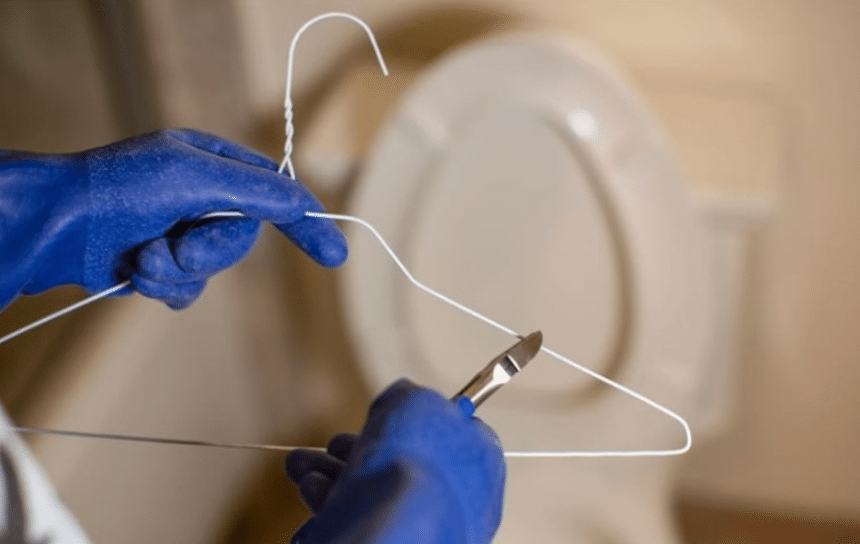 No-Tool Ways
No-Tool WaysIn some less critical cases, you can clean the toilet bowl yourself using unique cleaning products (baking soda, vinegar, etc.). For this purpose, chemical components should be poured instead of the jam and rinsed with water, according to the manufacturer’s requirement.
And performing the above operations yourself, you must take all precautions so as not to get burns of the skin and eyes and consider the structural features of the sewage system. After all, chemical reagents are neutral to plastic, porcelain, and cast iron, which chemical reagents cannot say about elements on a metal basis.
Professional plumbers do not recommend cleaning blockages with chemicals because, after the reaction, they can form a crust (sediment) and thus only worsen the situation. In addition, most agents are only able to dissolve organic clogs.
But we won’t discount the chemical method of a toilet flushing. There is a wide range of household chemicals on the market. You need to go to the nearest hardware shop and buy the product you like.
In life, there are different situations. What to do if the shop was not in the household cleaners department or no hardware shop nearby? You can do this by using local remedies.
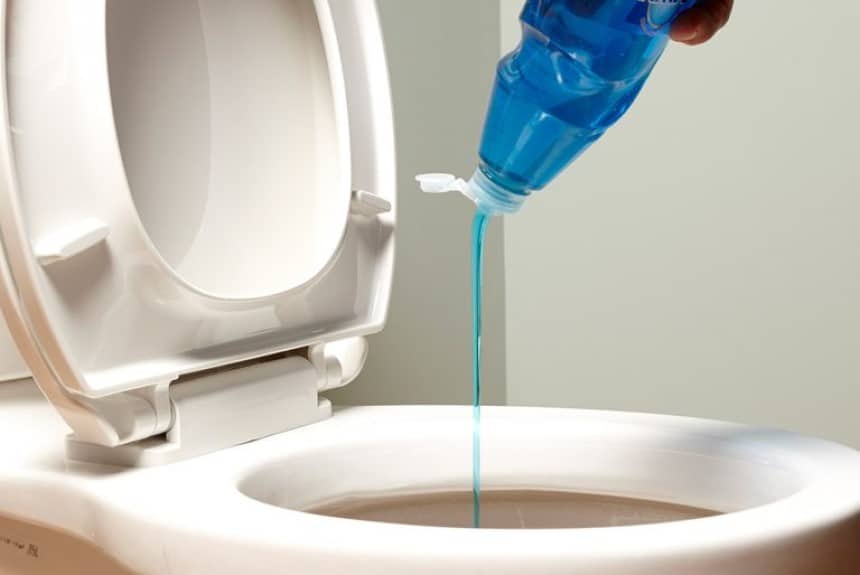
The principle of action of the compositions offered by manufacturers is to dissolve local deposits, thereby clearing the way for the unimpeded passage of water flows
Shop remedies are available as:
The chemical is poured or poured deep into the drain and waits for the period indicated on the label; after this time, the treated pipes are washed with hot water.
To enhance the effect of chemical treatment, some owners leave the composition for a more extended period than that indicated in the manufacturer’s instructions.
Keeping longer than the instructions is not advisable as it contains alkaline substances that can cause damage to the internal walls of the system.
For the same reason, it is unacceptable to use 2 or 3 products at the same time. The outcome of such experiments can follow one of two scenarios: either none of the products will work, or the cumulative effect of both compounds will have serious consequences.
Be sure to observe the requirements for the use of specific chemical products for unblocking clogs. The requirements will protect not only your toilet and its parts but also your health. As for chemicals incredibly, if mixed, they can react strongly and release toxic substances. Be careful.

The baking soda and vinegar react with each other to cause an “eruption” that helps remove grease and dirt deposits from the inner walls of the pipes.
The cleaning procedure is performed in several steps:
A glass of dry baking soda powder is poured into a previously emptied toilet flush. The glass must not mix the Baking Soda with water or cleaning agents.
Pour half a cup of room temperature vinegar down the drain.
The treated toilet flush should be sealed with a cotton cloth so that the reaction foam does not go down the drain but into the sewer pipe.
Leave the mixture poured into the pipe for about half an hour. During this time, it will dissolve the small debris and all deposits on the pipe walls.
Should be boiled a couple of liters of water. Half an hour after the baking soda has been poured in, open the hole and rinse it with boiling water.
It is not a good idea to use boiling water to treat plumbing fittings where the connection sleeves are thin-walled plastic. A final rinse, in this case, should preferably be carried out with 60–80 °C water.
We suggest another effective, but at first glance unusual, cleaning method.
An unusual use for Coca Cola
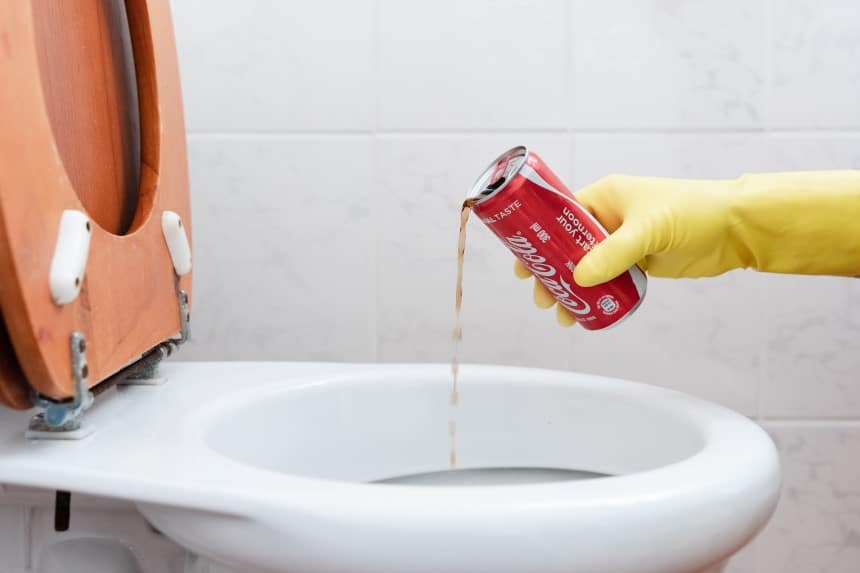
Phosphoric acid is even able to clean metal surfaces from rust. Not surprisingly, Coca-Cola can “eat away” grease and dirt deposits on the walls of pipes.
To clean your toilet, pour one liter of the drink down the drain and wait one hour. After this time, all you need to do is rinse the system with plenty of hot water.
If the clog is small and of organic origin, a bucket of hot water can help get rid of it. All you need is a bucket of hot water. But be careful: only try the method if you are sure of the quality of the earthenware. The coating could crack under the heat.
Do not use boiling water, just hot water. If you decide to use this method, start by pouring a small liquid to warm up the structure. Only then pour the bucket out. Wait a couple of minutes, and then drain the bucket.
Soap can come in handy to make a water solution. Soap is alkaline and, in addition to hot water, will help push the clog further down the drain.
Soap is an indispensable aid when unclogging a blockage with a plumber’s rope or hanger. It is good to lubricate the cable or coat the hanger with liquid or solid soap to make it easier to push the plumbing snake through and clear the blockage.
The course of action depends on the individual case. In an emergency, it can lead to incidents Trusted Source Toilet-related injuries and deaths - Wikipedia en.wikipedia.org . If you know exactly how to clear a clogged toilet yourself but have tried all the methods and still have not achieved results, you will still have to wait for a plumber.
Professional plumbers can clear a blockage quickly and easily. They will do this even if the cause of the backup is not in your toilet.
There is a situation in which a plumber must be called in immediately when the water in the toilet continues to flow despite attempts to clear the blockage. It means that the riser pipe is clogged below your floor level. When the upstairs neighbors keep draining water, the sewage will overflow over the toilet bowl’s edge and end up in your flat. Only professionals can deal with such a problem; they can unclog the toilet bowl and riser pipe.
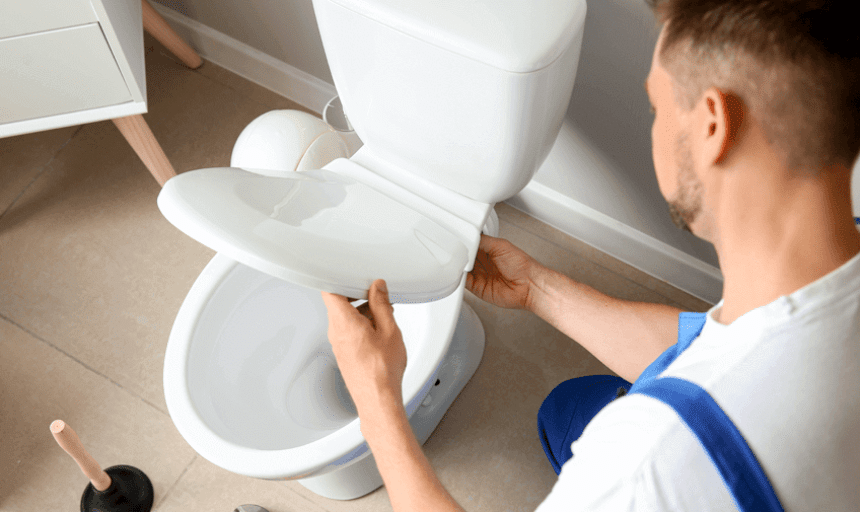 What Can Cause Toilet Clogging?
What Can Cause Toilet Clogging?Plumbing experts name the following factors that lead to such a blockage:
In addition to natural human waste, the water contains minerals that are also deposited inside the pipe. If the sewer pipe is not installed correctly, e.g., insufficient gradient, deposits will gradually build up in the tube during draining. Over time this can lead to blockages.
Another reason for a blockage in the sewer pipe is a lack of adequate sanitary ventilation.
If the sewer system is to work correctly, it must be ventilated in the riser pipe; otherwise, the flow velocity of the liquid decreases and a blockage can occur.
But the most common reason for a clogged toilet is that the bathroom is not being used properly by the user. Without thinking about the consequences, households pour a variety of poorly soluble substances into the toilet bowl. Large food waste, cat litter, large pieces of paper, etc., which have been thrown down the toilet waste pipe, can cause a blockage. Sometimes the landlady may accidentally pour a floor washing rag down the toilet together with dirty water.
If a cat lives in your flat and uses litter box litter, read the disposal instructions carefully. The fact is that mineral, lumpy and absorbent litter is made of clay. When the clay enters the sewer system, the water will permanently cement the duct, and only a professional can remove the concrete plug.
Any problem is easier to prevent than to correct. There are some simple rules you should follow to avoid a recurrence.
Do not throw foreign objects into the toilet bowl. To avoid accidentally throwing things in, do not put racks of small objects next to the toilet.
If a large object falls into the toilet, remove it immediately before it reaches the drain hole.
Use filters that trap large particles of debris. It is imperative when emptying the toilet bowl with dirty water after cleaning.
Press the flush button after each time you use the toilet for its intended purpose. Flushing the system in good time will prevent limescale and urine deposits from settling.
Educational talks with children. Young children love to put the plumbing system to the test by “bathing” their toys in it. Explain to them that this is strictly forbidden.
Replace rusty pipes. The rough surface of a rusty pipe speeds up the formation of all kinds of deposits. If this is neglected, there is a risk that will form again and again.
To ensure that your plumbing system lasts as long as possible, use a chemical preventative. It will prevent grease blockages that often build up in the bends of the toilet bowl and around the drain hole.
The primary prevention task is to take good care of your entire home Trusted Source The new household rules: ditch your toilet brush and wash much, much more | Homes | The Guardian How many towels does one person need? Should you change your sheets each week? And do you really have to clean the toilet with nothing but your rubber gloves? Experts on 10 modern domestic dilemmas <br> www.theguardian.com . Because following simple rules of hygiene and healthy living will not give you a chance to compromise the integrity of your drainage system.
There are quite a few ways to clear blockages at home. Depending on the depth and severity of the jam, one or more of the methods described above may be suitable for you.
But if none of them have helped you, you should call in professionals who will quickly and efficiently deal with any blockages, even if you have to remove your toilet bowl. Professional plumbers will also come to the rescue if you have a complicated modern or Smart toilet and are afraid of damaging it with careless actions.
